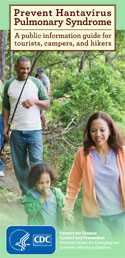Cleaning Up After Pet Rodents to Reduce the Risk of Seoul Virus Infection
Interim Recommendations
People handling the brown or Norway rat, the known carrier of Seoul virus (a species of hantavirus that can be spread by this type of rat), should take special precautions to minimize risk of infection. Special consideration should be given to:
- protection of bare skin and mucous membranes from contact with rodent excreta and nesting materials,
- hand hygiene,
- cleaning method for rodent housing environments and habitats,
- choice and use of disinfectants,
- decontamination of equipment, and
- proper disposal of waste.
The following are interim recommendations to reduce the risk of of Seoul virus infection. These recommendations will be revised and updated as additional information becomes available.
Cleaning Up After Rodents
Take the following precautions before, during, and after a cleaning an area that was occupied by rodents (either due to infestation or when cleaning rodent housing environments and habitats):
- Before starting to clean, ventilate the space by opening doors and windows for at least 30 minutes to allow fresh air to enter the area. Use cross-ventilation whenever possible. It is important for all people to leave the area during the airing-out period.
- To clean up any urine and droppings
- Wear rubber, latex, or vinyl gloves when cleaning rodent urine and droppings.
- When you begin cleaning, it is important that you do not stir up dust by sweeping or vacuuming up rodent urine, droppings, or nesting materials.
- Spray the urine and droppings with a disinfectant or a mixture of bleach and water and let soak for 5 minutes. The recommended dilution of bleach solution is 1 part bleach to 9 parts water (10% solution). When using a commercial disinfectant, follow the manufacturer’s instructions on the label for dilution and disinfection time.
- Use a paper towel to pick up the urine and droppings, and dispose of the waste in the garbage.
- After the rodent urine and droppings have been removed, disinfect surfaces and items that might have been contaminated by rodents or their urine and droppings.
- When you’re done with cleaning, remove gloves and put in the garbage, and thoroughly wash hands with soap and water (or use a waterless alcohol-based hand rub when soap is not available and hands are not visibly soiled; however it is important to wash hands with soap and water as soon as a sink is available).
Disinfectants
Hantaviruses like Seoul virus are sensitive to diluted hypochlorite solutions (10% household bleach), 5% hospital-grade disinfectants, phenolics, detergents, and most general-purpose household disinfectants.
- A 1% solution of household bleach (1:100 dilution) is an adequate surface disinfectant, which can be used for wiping down potentially contaminated surfaces.
- A 10% solution of bleach (1:10 dilution) is recommended for heavily soiled areas or items contaminated with rodent urine, droppings, or nesting materials.
An appropriate disinfectant should always be used to:
- Decontaminate traps which contained or were soiled by rodents (urine or droppings).
- Clean rubber gloves after handling traps which contain rodents or that have been soiled by rodents
- Clean gloved hands after each rodent is handled and before removing gloves,
- Soak and disinfect instruments and other equipment.
- Clean working surfaces and other items that may have been contaminated by handling rodents,
Personal Protective Equipment
Different equipment is recommended depending on the activity. People who have rats as pets should wear gloves when cleaning rodent environments and follow cleaning directions above to clean their pet’s habitats to help reduce the risk of Seoul virus.
People who clean up after heavy rodent infestations should wear the protective equipment listed here:
- coveralls (disposable, if possible);
- rubber boots or disposable shoe covers;
- rubber, latex, or vinyl gloves;
- protective goggles;
- appropriate respiratory protection device, like a half-mask air-purifying (or negative-pressure) respirator with a high-efficiency particulate air (HEPA) filter or a powered air-purifying respirator (PAPR) with HEPA filters. Follow local and state requirement regarding pulmonary function and fit testing before beginning any work requiring the use of a respirator.
Personal protective gear should be decontaminated upon removal at the end of each day the equipment is in use. All potentially infective waste material (including respirator filters) from clean-up operations that cannot be burned or deep-buried on site should be double-bagged in appropriate plastic bags. The bagged material should then be labeled as infectious (if it is to be transported) and disposed of in accordance with local requirements for infectious waste.
Contact Information
If you have question, you can call CDC-INFO at 800-CDC-INFO (800-232-4636), TTY: 888-232-6348 or email CDC-INFO.
Related Links
For more information about Seoul virus, read frequently asked questions about Seoul virus infection.
For recommendations on safe handling of pet rodents, read Key Messages About Pet Rodents.
For recommendations on rodents used for pet food, read Key Messages About Rodents Used for Pet Food.
- Page last reviewed: January 19, 2017
- Page last updated: January 19, 2017
- Content source:



 ShareCompartir
ShareCompartir